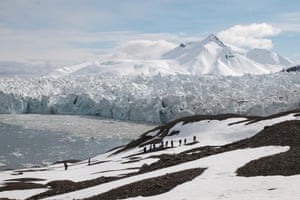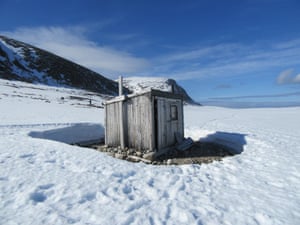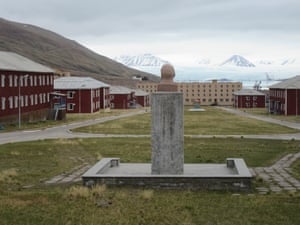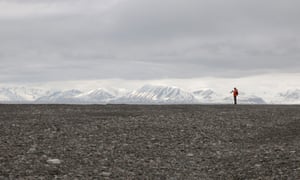As Britain faced a heatwave, the Observer’s architecture critic found
himself between Norway and the north pole, exploring icy Svalbard on an
epic trip for artists and writers
In a tragicomic photograph
to be found on the internet, a hydrogen balloon lies sideways on the
sea ice, somewhere north of Svalbard. Still inflated, it clings to its
spherical dignity, while the ropes that connect it to its upended basket
describe elegant. It is a dark silhouette against a horizonless
surround, in which the white ice of the foreground grades into a lightly
greying sky.
The two men posing by the basket and the one behind the camera don’t have long to live. They will make it across the ice back to land but, with inadequate provisions and equipment, will die there. It will take some decades before their remains and their camera are found. Such was the fate of the 1897 expedition, brave to the point of idiocy, in which the Swede SA Andrée tried to fly to the north pole. He used a steering system that was almost certain not to work, and he set off in his newly made balloon without final checks for leaks.
The Arctic can have this effect on people: its function in the imagination of the world is as a place to test or define, to look for some truth about existence by viewing it from its limit. The challenge of its otherness might explain why Mary Shelley chose to open Frankenstein in the Arctic wastes, and why the Soviets built the showcase coalmining town of Pyramiden more grandly and formally than its function required. Now the significance of the Arctic is above all about climate change, its effects there being particularly visible, significant and dangerous.
"What if we couldn’t stand each other, on this vessel alone on icy seas? Agatha Christie would have loved the scenario"
The belief that the Arctic has something to tell us motivates the Arctic Circle residency, a programme whereby artists, scientists and writers can, for half the actual cost, take part in expeditions aboard a tall sailing ship, around the coasts and islands of Svalbard. Feeling the need for new perspectives on life, I applied – and in early June joined 28 other participants, plus guides and crew, on the three-masted barquentine Antigua. Two weeks without night or internet, ignorant of World Cup results and the latest Trump eruptions, voyaging between 78 and 81 degrees north, going where the wind suggested, marvelling at glaciers in shades of blue beyond the power of words or cameras to capture – cobalt? cerulean? sapphire? “Are you going to find yourself,” teased a friend, “under an iceberg?”
Svalbard’s shape on a map, a splat of kelp upon a rock, may be the least familiar in Europe. It occupies the zone where Mercator’s and other projections dissolve into absurdity, with Svalbard becoming either nonsensically big or weirdly distorted, sometimes getting left out altogether. On globes it can disappear beneath the black plastic cap that holds the object in place. An azimuthal projection, the kind that puts the north pole at the centre of concentric circles of latitude, reveals it to have more to do with the cold family of Arctic lands – Greenland, the islands of north Russia and Canada – than with the European mainland.
Human history has a shallow grip on Svalbard. Before Barents (or those Vikings) arrived, there were no indigenous populations, no equivalent of Inuit in north America, nobody at all. It wasn’t until the 20th century that people started living there permanently, and such life has been extreme, framed by tales of endurance and danger: explorers stuck in the ice through long winters, stranded travellers surviving in snow holes for months, whalers taking insane risks in pursuit of profit, the appalling working conditions and mortality rates of miners.

The two men posing by the basket and the one behind the camera don’t have long to live. They will make it across the ice back to land but, with inadequate provisions and equipment, will die there. It will take some decades before their remains and their camera are found. Such was the fate of the 1897 expedition, brave to the point of idiocy, in which the Swede SA Andrée tried to fly to the north pole. He used a steering system that was almost certain not to work, and he set off in his newly made balloon without final checks for leaks.
The Arctic can have this effect on people: its function in the imagination of the world is as a place to test or define, to look for some truth about existence by viewing it from its limit. The challenge of its otherness might explain why Mary Shelley chose to open Frankenstein in the Arctic wastes, and why the Soviets built the showcase coalmining town of Pyramiden more grandly and formally than its function required. Now the significance of the Arctic is above all about climate change, its effects there being particularly visible, significant and dangerous.
"What if we couldn’t stand each other, on this vessel alone on icy seas? Agatha Christie would have loved the scenario"
The belief that the Arctic has something to tell us motivates the Arctic Circle residency, a programme whereby artists, scientists and writers can, for half the actual cost, take part in expeditions aboard a tall sailing ship, around the coasts and islands of Svalbard. Feeling the need for new perspectives on life, I applied – and in early June joined 28 other participants, plus guides and crew, on the three-masted barquentine Antigua. Two weeks without night or internet, ignorant of World Cup results and the latest Trump eruptions, voyaging between 78 and 81 degrees north, going where the wind suggested, marvelling at glaciers in shades of blue beyond the power of words or cameras to capture – cobalt? cerulean? sapphire? “Are you going to find yourself,” teased a friend, “under an iceberg?”
Svalbard’s shape on a map, a splat of kelp upon a rock, may be the least familiar in Europe. It occupies the zone where Mercator’s and other projections dissolve into absurdity, with Svalbard becoming either nonsensically big or weirdly distorted, sometimes getting left out altogether. On globes it can disappear beneath the black plastic cap that holds the object in place. An azimuthal projection, the kind that puts the north pole at the centre of concentric circles of latitude, reveals it to have more to do with the cold family of Arctic lands – Greenland, the islands of north Russia and Canada – than with the European mainland.
Human history has a shallow grip on Svalbard. Before Barents (or those Vikings) arrived, there were no indigenous populations, no equivalent of Inuit in north America, nobody at all. It wasn’t until the 20th century that people started living there permanently, and such life has been extreme, framed by tales of endurance and danger: explorers stuck in the ice through long winters, stranded travellers surviving in snow holes for months, whalers taking insane risks in pursuit of profit, the appalling working conditions and mortality rates of miners.

Instead there is naked geology, exemplary sedimentary mountains whose layers were formed by hundreds of millions of years of shifting land and sea, back to a time when what is now Svalbard was located south of the equator. On one edge, where plate movements pressed it against what is now Greenland, they twist and buckle. Elsewhere equally exemplary igneous rocks, formed in intense heat and pressure in the earlier history of the planet, create the hard, spiky skylines that gave Spitsbergen (“pointed mountains”) its name.
Formations that in other lands would be worth a journey by themselves are here commonplace. They are unforgiving, even tedious, in their sterile magnificence. Animation comes from the clarity, luminosity and subtle alterations of the famous Arctic light. Because the light reflects in all directions off snow and ice, and because sunshine comes (especially around midnight) at a low angle, you are suspended in it. At the same hour, when the shadows deepen and when a light meter would register a lowering of levels but all still looks dazzling, there is a bright-dark quality comparable to that of a solar eclipse.
Along with rock and light, the landscape is made of four other elements – ice, snow, cloud and water – all, of course, variants of the same substance. Their changes and interactions are infinite. You know them underfoot, hard or collapsing, as well as by sight. Above all, there are the glaciers, one after another, covering much of Svalbard, crackling and growling with their internal forces, crumbling into pillars and pinnacles with the unsteady and unlikely beauty of the about-to-collapse. One in particular, the currently surging glacier of Wahlenbergbreen, resembles an army of orks, ranks of ugly upright giants marching to their collapse into the sea, where they will turn into glistening floating ornaments, whose cute technical name is “bergy bits”.
You see clearly that everything is in inorganic motion, if at different speeds – waves, ice, strata, continental plates, weather. There are similarities of patterns: a field of moss looks like a mountain range, ice floes drift like clouds, glacier ice behaves like rock, only speeded up. All landscapes are temporary, as the architect Cedric Price said of buildings, but some are more temporary than others.
The Arctic’s absence of measures like trees and houses makes it hard to read the scale of a glacier – 100ft high? 400ft? More? Dry haze-less air makes distance inscrutable, removing the aerial perspective that helps us read depth. The sun’s 24-hour, 360-degree path messes with time and orientation. It is otherworldly. It is a sketch of another planet. It is not greatly bothered about human presence, even though human presence has the potential to be devastating: whatever the poltroons who deny it might say, this ice is indeed retreating and, quite apart from its effects when it turns up in melted form in a town or field near you, a world of beauty will be destroyed.

“Don’t get eaten by a polar bear” was common advice before I left, but Other People were scarier. What if we couldn’t stand each other, on this vessel alone on icy seas? Agatha Christie would have loved the scenario: a confined space, multiple personal histories, several ways to die. It didn’t seem auspicious that my allocated cabin-mate greeted me with a box of earplugs and the warning that he snores. But I slept, partly by imagining that his occasional rumblings were the sounds of glaciers or walruses. Collectively we participants got along well, not only because it was clearly dumb not to, but also because this was a group of likable and dedicated people. There were irritations, to be sure, and occasional outbreaks of what might be considered madness, but the overwhelming experience was the pleasure of encountering people we wouldn’t have met otherwise, and making lasting friendships.
We were conscious of a precedent – in 2005 a group called Cape Farewell organised a residency in Svalbard that included Ian McEwan and Antony Gormley, that formed the basis of McEwan’s novel Solar. We were a less starry bunch but possibly we had a better time, not least because they went in the harsh month of March. It helped that we were lucky with wildlife – two blue whales within an hour of leaving port, six bears in three sightings, an extended viewing of an ugly of walruses, plus seals, arctic fox, reindeer and an array of birds. (And, yes, according to some contested sources an “ugly” is a collective noun for those large brown sea beasts.)
If it would be nice to tell daring tales of narrow escapes but the truth is that dangerous places have to be highly managed. On land, you can’t leave the protection of the guides, who are armed with rifles as a last resort against polar bears (although there was a mildly alarming moment involving a grounded boat and a curious bear). You could swim in the extremely cold water or go up the ship’s foremast in a safety harness, but these are hardly epic adventures.
Rather, we busied ourselves with our personal attempts to respond to the Arctic. Adam Kuby, a public artist from Portland Oregon, filled a crack in ice with gold-coloured fabric and photographed it. Emma Hoette, one of the crew, who is currently studying at the Laban centre in London, reprised a performance where she sits on a cold rock, naked but for a woollen neck warmer that she slowly unravels. Philip Kanwischer, from Calgary, made a digitally altered photograph of our anxieties: that curious bear multiplied several times over. All had to observe the same rule: you may leave nothing behind on the islands and beaches and take nothing away. Any manmade objects that might be older than 1946 – barrel hoops, shoes, broken bottles — are designated as cultural artefacts and must not be touched.
"The Arctic doesn’t give a damn about us. If it could have a preference, it would want us dead"
Writers took notes for future poems and essays. I read an account of the 1873 expedition of the explorer Benjamin Leigh Smith, who happens to have been my great-great-great uncle, and traced the intersections of his routes with ours. In Mosselbukta, where he found a Swedish expedition that had spent the Arctic winter trapped by ice, I saw the ruins of a flatpacked house these pre-Ikea Swedes had built. It later collapsed; its timbers are miraculously preserved by the dry, cold air.
As a writer on architecture, I had imagined that the appeal of the Arctic would include its lack of my usual subject matter, but there are buildings there too, all the more poignant for their survival in hostile places. There are the structures of coalmining, mineheads perched on near-cliffs and long-legged conveyor systems that recall the inventions of HG Wells or the Walking Cities of the 1960s architectural group Archigram. There are trappers’ huts, researchers’ cabins and tiny refuges for travellers, all solitary specks in the vast landscape. There is the steel mast from which in 1926 Raoul Amundsen and Umberto Nobile, at that point collaborating with each other, flew in an airship to the north pole.
These structures are to the point. They waste no energy. They combine flimsy-looking tarpaper with oversized driftwood because that is what is to hand. It would be lost effort to cut up the wood into more proportionate pieces. Decorated at most with reindeer antlers or a bear’s jawbone, they have the striking aesthetic of buildings that don’t have time for aesthetics, their unusual asymmetries of lightness and mass being responses to unusual conditions.

In its 1970s heyday it was an exhibition town, a sought-after posting for Soviet citizens, with model apartment buildings and the world’s northernmost bust of Lenin gazing down an avenue nicknamed the Champs Élysées. It has the only turf in Svalbard, imported from the Ukraine, on which the only dandelions sometimes flower. It has a shed where strawberries were grown. Its buildings are higher than anywhere else in the archipelago, and its mining structures more elaborate and massive – as much to make them impressive as out of necessity. As an exercise in pitting man against nature, with the associated effects of hubris, it has something in common with the Swedish balloon.
Svalbard architecture exposes with special lucidity the heroism and foibles of human life, which is what the Arctic does more generally. It doesn’t give a damn about us. If it could have a preference, it would want us dead. But its very implacability makes us want to read ourselves in it and enables us to do so. The message of those sedimentary mountains is that, over a scale of tens of millions of years, nature will probably shrug off whatever monstrosities we inflict on it, as it has previous catastrophes like meteorites and volcanic explosions, but that will be much too late for us. This realisation makes climate change more urgent, not less. We made this problem and it is down to us to fix it. There is no one and nothing else to help us.
It’s a little preposterous to seek the meaning of the Arctic, but if it has one it’s in what it reflects. One of the strangest sights was, after 10 days’ sailing, of a man we hadn’t met before. Wonders included the rediscovery, over a return via Oslo airport to Britain, of crowds, summer warmth, trees, trucks, streetlamps, passwords, football results and new Trump eruptions much like the old ones, of a snail trail and a mulberry bush in the garden. Some of these things seemed inconsequential, some repulsive, some precious. A possibly obvious truth was vividly reinforced, which is that there is no fundamental reason why any of them are here. We’d miss them, some of them, if they weren’t.

No comments:
Post a Comment